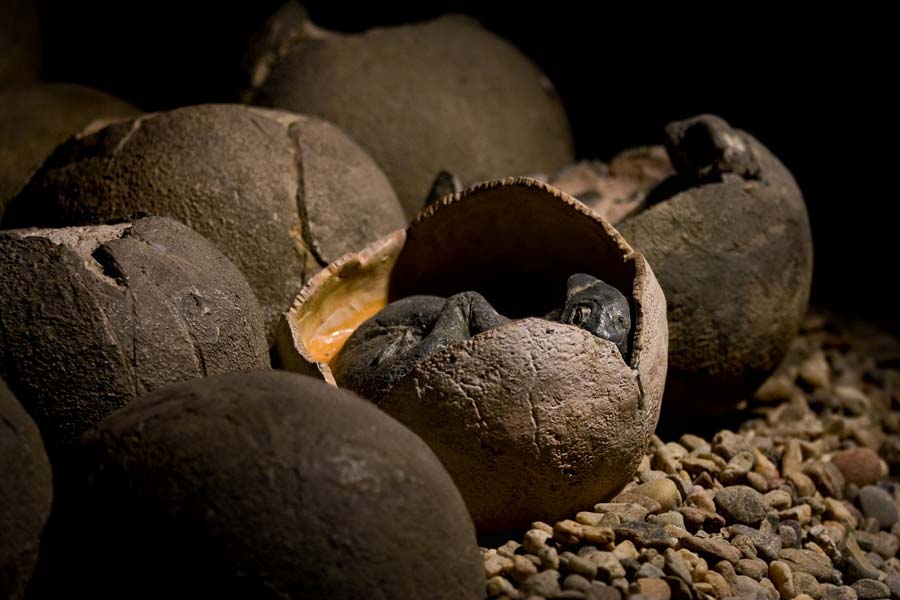
Scientists have made a major discovery in the southern Chinese city of Ganzhou in Jiangxi Province. They found the remains of a dinosaur perched on its nest of fossilized eggs.
The dinosaur, an oviraptorosaur (oviraptor), belongs to a group of theropod dinosaurs resembling a bird that reached its peak in the distant Cretaceous (145 to 66 million years ago). The fossils of the adult oviraptor and the eggs with embryos were dated to about 70 million years ago. This is the first time researchers have found a non-avian dinosaur perched on a nest of eggs that have been fossilized, so they still contain babies inside!

The 70-million-year-old fossil in question: an adult theropod dinosaur oviraptorid perched on top of a nest of its fossilized eggs. Several eggs (including at least three containing embryos) are clearly visible, as are the adult’s forearms, pelvis, hind limbs and partial tail. (Shundong Bi, Indiana University of Pennsylvania)
What do scientists say about the discovery?
Dr. Shundong Bi, from the Center for the Evolutionary Vertebrate Biology, Institute of Paleontology, Yunnan University, China, Department of Biology, Indiana University of Pennsylvania, USA, and lead author of the study, told EurekAlert! their nests are rare, as are fossil embryos. It is the first time a non-avian dinosaur has been found, perched on an egg nest that holds embryos, in a single spectacular specimen. ”
Although there are a few other examples of adult oviraptor found on their egg nests, this is the first time scientists have found embryos inside eggs. Co-author of the study, Dr. Lamanna, a paleontologist at the Carnegie Museum of Natural History, USA, explains: “This type of discovery, in essence, fossilized behavior, is the rarest of the dinosaurs. Although several adult oviraptorids have been found on the nests of their eggs before, no embryos have ever been found inside these eggs. ”
Dr. Xu, of the Institute of Vertebrate Paleontology and Paleoanthropology in Beijing, China, and one of the study’s authors, expects this rare discovery to hold a wealth of information, “It’s amazing to think about how much biological information is captured. in this single fossil. Dr. Xu says, “We will learn from this specimen for many years to come.”

An alert oviraptorid theropod dinosaur finds its nest of blue-green eggs, while its partner looks at what is now Jiangxi Province in southern China, about 70 million years ago. ( Zhao Chuang )
Fossilized eggs were about to hatch!
Scientists have discovered an incomplete skeleton of an adult oviraptor with pebbles in his stomach. This is an example of gastroliths, “Stomach Stones,” which the creature had consumed to help it digest its food. It is also the first example of indisputable gastrolitis found in an oviraptorid, which the team believes could provide new information about the diet of these dinosaurs.
The dinosaur was found crouched above the nest of at least 24 fossilized eggs, in an overwhelming or protective position. This suggests that the dinosaur died while contemplating or protecting its children. However, when researchers used oxygen isotope analyzes on eggs, they found that they were incubated at high temperatures, similar to birds, which support the belief that the adult most likely died while burying their nest.

The partial skeleton of the oviraptorosaur was found on a nest of at least 24 fossilized eggs. ( Bi et al., Science Bulletin, 2020 )
At least seven of the fossilized eggs still contain remnants of hatching oviraptorid embryos. Based on the development of the embryos, scientists believe that some of the eggs were on the verge of hatching. According to Dr. Lamanna, “This dinosaur was a caring parent who eventually gave his life while caring for his cubs.”
The article is published in The scientific bulletin .
Top image: Representative image of a baby dinosaur in an egg. Source: KtD / Adobe Stock
By Alicia McDermott